A Cultural and Environmental Assessment of a Landscape Archetype with Dispersed Settlements in Čadca Cadastral District, Slovakia
Abstract
1. Introduction
1.1. Archetypes of Cultural Landscapes
1.2. Historical Genesis of Dispersed Settlements in Slovakia and the Research Objectives
2. Materials and Methods
2.1. Study Area
2.2. Research Methodology
2.2.1. Analysis of Natural Settings and Socioeconomic Factors of the Study Area and the Field Survey
2.2.2. Land Cover Analysis and Multitemporal and Spatial Context of Dispersed Settlements
- Military maps (scale of 1:28,880): I. Military Map (1780–1784) and II. Military Map (1819–1824);
- Historical military topographic map (scale of 1:25,000) (after 1956);
- Orthomosaic photos (scale of 1:10,000) and the best base for land cover details was a colored large-scale aerial photo (2011);
- Aside from maps, accessible historical documents and time photos were also used.
2.2.3. Identification and Evaluation of Historical Structures in the Context to Landscape Archetypes with Dispersed Settlements
2.2.4. Sociological Survey through a Questionnaire
2.2.5. The Assessment of Landscape Archetypes with Dispersed Settlements for Proposals of Management Measures and Incentives
- The field survey and the inventory datasheet containing the following information and attributes: basic data; landscape evaluation concerning attributes of age and condition of family houses, condition of land use, preservation degree of folk architecture, settlement structure and the presence of historical agristructures; residents’ evaluation concerning the number of residents and character of the local community (permanent or seasonal inhabitants); other data on specific features increasing or degrading the DSU value. Examples and details are given in the Supplementary Materials.
3. Results
3.1. Natural Settings and Social Conditions of Study Area in Relation to Land Use Managed by Dispersed Settlements
3.2. Evaluation of Land Cover and Historical Structures of the Landscape Archetypes with Scattered Settlements
3.2.1. Current Land Cover in the Study Area
3.2.2. Multitemporal Land Cover Changes
3.2.3. Evaluation of Historical Structures Related to Landscape Archetype with Dispersed Settlements
3.3. Sociological Survey Results
3.4. The Assessment of Landscape Archetypes with Dispersed Settlements
3.4.1. The Assessment of Positive and Negative Elements and Phenomena Influencing the Quality of the Landscape Archetype with Dispersed Settlements
3.4.2. The Assessment of the Quality of DSUs for Proposals of Future Measures and Incentives
4. Discussion and Conclusions
4.1. Landscape Archetypes of Dispersed Settlements as Distinguished Features of the Landscape Character
4.2. Proposals of Management Measures and Incentives for Landscape Archetype with Dispersed Settlements
- First level of DSU protection—Intended to maintain and preserve the entire original settlement structure in a given landscape archetype of DSU, including all elements of folk architecture. In the case of new construction or the reconstruction of traditional buildings, typical regional architectural elements must be strictly respected. These elements are mainly visual features of the landscape and are related to DSU 2 and DSU 3 (viewpoints for tourists and monitoring sites are marked by numbers in Figure 10).
- Second level of DSU protection—Intended to maintain and preserve the partial original settlement structure in a given landscape archetype of DSU, including some elements of folk architecture. In the case of new construction or reconstruction of traditional buildings, its typical regional architectural elements must be strictly respected. These elements are not visible features of the landscape or related to DSU 3.
4.3. Strategic Planning of Sustainable Land Use Management and Maintenance on Landscape Archetypes with Dispersed Settlements
Supplementary Materials
Author Contributions
Funding
Institutional Review Board Statement
Informed Consent Statement
Data Availability Statement
Conflicts of Interest
References
- Zhang, L.; Guang, T.Z. Approach of Landscape Imagery Based-on Archetype Theory. Chin. Landsc. Archit. 2014, 5, 40–43. [Google Scholar]
- Hreško, J.; Petrovič, F.; Mišovičová, R. Mountain landscape archetypes of the Western Carpathians (Slovakia). Biodivers Conserv. 2015, 24, 3269–3283. [Google Scholar] [CrossRef]
- Miklós, L.; Špinerová, A.; Belčáková, I.; Offertálerová, M.; Miklósová, V. Ecosystem Services: The Landscape-Ecological Base and Examples. Sustainability 2020, 12, 10167. [Google Scholar] [CrossRef]
- Tieskens, K.F.; Schulp, C.J.E.; Levers, C.; Lieskovský, J.; Kuemmerle, T.; Plieninger, T.; Verburg, P.H. Characterizing European cultural landscapes: Accounting for structure, management intensity and value of agricultural and forest landscapes. Land Use Policy 2017, 62, 29–39. [Google Scholar] [CrossRef]
- Xiao-li, J.; Fei, H. Archetype precipitation of emotional transmission. Mod. Commun. 2017, 5, 12–15. [Google Scholar]
- Cullum, C.; Rogers, K.H.; Brierley, G.J. Ecological classification and mapping for landscape management and science: Foundations for the description of patterns and processes. Prog. Phys. Geogr. 2016, 40, 38–65. [Google Scholar] [CrossRef]
- Vidal Merino, M.; Sietz, D.; Jost, F.; Berger, U. Archetypes of climate vulnerability: A mixed-method approach applied in the Peruvian Andes. Clim. Dev. 2019, 11, 418–434. [Google Scholar] [CrossRef]
- Václavík, T.; Langerwisch, F.; Cotter, M.; Fick, J.; Häuser, I.; Hotes, S.; Kamp, J.; Settele, J.; Spangenberg, J.H.; Seppelt, R. Investigating potential transferability of place-based research in land system science. Environ. Res. Lett. 2016, 11, 095002. [Google Scholar] [CrossRef]
- Šulcová, L.; Nemčíková, M.; Veselovský, J.; Kramáreková, H. Changes in functional use of dispersed settlements in Slovakia (Case study Novobanská štálová area. In Socioeconomic Geography: Teaching and Education in Geography, Proceedings of Geobalcanica 2015; Geobalcanica Society: Skopje, Macedonia, 2015; pp. 419–427. [Google Scholar]
- Cullum, C.; Brierley, G.; Perry, G.L.W.; Witkowski, E.T.F. Landscape archetypes for ecological classification and mapping: The virtue of vagueness. Prog. Phys. Geogr. Earth Environ. 2017, 40, 38–65. [Google Scholar] [CrossRef]
- Sietz, D.; Frey, U.; Roggero, M.; Gong, Y.; Magliocca, N.; Tan, R.; Janssen, P.; Václavík, T. Archetype analysis in sustainability research: Methodological portfolio and analytical frontiers. Ecol. Soc. 2019, 24, 34. [Google Scholar] [CrossRef]
- Jacob, K. Images, Figures and Qualities: Clarifying the Relationship Between Individual and Archetype, SInternational. J. Transpers. Stud. 2016, 35, 93–102. [Google Scholar] [CrossRef]
- Urbanc, M.; Gašperič, P.; Kozina, J. Geographical imagination of landscapes: Analysis of the book of photographs Slovenian landscapes. Acta Geogr. 2015, 55, 101–115. [Google Scholar] [CrossRef]
- Tortora, A.; Statuto, D.; Picuno, P. Rural landscape planning through spatial modelling and image processing of historical maps. Land Use Policy 2015, 42, 71–82. [Google Scholar] [CrossRef]
- Smrekar, A.; Zorn, M.; Komac, B. Heritage protection through an geomorphologist’s eyes: From recording to awareness raising. Acta Geogr. 2016, 56, 123–127. [Google Scholar] [CrossRef]
- Nash, R. Archetypal Landscapes and the Interpretation of Meaning. Camb. Archaeol. J. 1997, 7, 57–69. [Google Scholar] [CrossRef]
- Eisenack, K.; Gotgelf, A.; Kasymov, U.; Lutz, P.; Perez, P.; Oberlack, C.; Sietz, D. Second Research Workshop on Archetype Analysis in Sustainability Research; Workshop Report; Humboldt Universität zu Berlin: Berlin, Germany, 2018. [Google Scholar]
- Chen, C.; Da-Ping, L. Analysis of Spatial Configuration Derivation of Archetype Image of Traditional Landscape Architecture. Archit. J. 2015, S1, 162–165. [Google Scholar]
- Hodder, I.R.; Shanks, M.; Alexandri, A.; Buchli, V.; Carman, J.; Last, J.; Lucas, G. Interpreting Archaeology: Finding Meaning in the Past, 1st ed.; Routledge: London, UK, 1995. [Google Scholar]
- Izakovičová, Z. Ecological interpretations and evaluation of encounters of interests in landscape. Ekológia 1995, 14, 261–275. [Google Scholar]
- Wardropper, C.B.; Gillon, S.; Mase, A.S.; McKinney, E.A.; Carpenter, S.R.; Rissman, A.R. Local perspectives and global archetypes in scenario development. Ecol. Soc. 2016, 21, 21–38. [Google Scholar] [CrossRef]
- Oberlack, C.; Tejada, L.; Messerli, P.; Rist, S.; Giger, M. Sustainable livelihoods in the global land rush? Archetypes of livelihood vulnerability and sustainability potentials. Glob. Environ. Chang. 2016, 41, 153–171. [Google Scholar] [CrossRef]
- Karrasch, L.; Klenke, T.; Kleyer, M. Land-use elements and attributed ecosystem services: An archetype approach to landuse evaluation at the German North Sea coast. Ecol. Soc. 2019, 24, 13. [Google Scholar] [CrossRef]
- Huba, M. Operspektívach kopaničiarskeho osídlenia a kopaničiarskej krajiny na území Slovenskej republiky. Geogr. Časopis 1990, 42, 113–130. [Google Scholar]
- Belčáková, I.; Pšenáková, Z. Specifics and landscape conditions of dispersed settlements in Slovakia—A case of natural, historical and cultural heritage. In Best Practices in Heritage Conservation and Management. From the World to Pompeii, Proceedings of the Le vie dei Mercanti: XII Forum Internazionale di Studi, Napoli, Italy, 12–14 June 2014; Gambardella, C., Ed.; La Scuola di Pitagora Editrice: Napoli, Italy, 2014; pp. 261–268. [Google Scholar]
- Petrovič, F.; Muchová, Z. The potential of the landscape with dispersed settlement (case study Čadca town). In Proceedings of the Conference on Public Recreation and Landscape Protection—with Man Hand in Hand, Brno, Czech Republic, 1–3 May 2013; pp. 199–204. [Google Scholar]
- Barančoková, M.; Barančok, P. Distribution of the traditional agricultural landscape types reflecting geological substrate and slope processes in the Kysuce Region. Ekológia 2015, 34, 339–355. [Google Scholar]
- Owen, S.; Herlin, I.S. The Sustainable Development of Dispersed Settlement in the High Weald AONB. In Final Report to the High Wealad AONB Joint Advisory Commitree and English Heritage; Countryside and Community Research Institute: Gloucester, MA, USA, 2007; p. 32. [Google Scholar]
- Špulerová, J.; Petrovič, F.; Mederly, P.; Mojses, M.; Izakovičová, Z. Contribution of traditional farming to ecosystem services provision: Case studies from Slovakia. Land 2018, 7, 74. [Google Scholar] [CrossRef]
- Oborn, E.; Barrett, M.; Prince, K.; Racko, G. Balancing exploration and exploitation in transferring research into practice: A comparison of five knowledge translation entity archetypes. Implement Sci. 2013, 8, 104. [Google Scholar] [CrossRef] [PubMed]
- Gullino, P.; Devecchi, M.; Larcher, F. How can different stakeholders contribute to rural landscape planning policy? The case study of Pralormo municipality (Italy). J. Rural Stud. 2018, 57, 99–109. [Google Scholar] [CrossRef]
- Václavík, T.; Lautenbach, S.; Kuemmerle, T.; Seppelt, R. Mapping global land system archetypes. Glob. Environ. Chang. 2013, 23, 1637–1647. [Google Scholar] [CrossRef]
- Picuno, P.; Cillis, G.; Statuto, D. Investigating the time evolution of a rural landscape: How historical maps may provide environmental information when processed using a GIS. Ecol. Eng. 2019, 139, 105580. [Google Scholar] [CrossRef]
- Suziedelyte Visockiene, J.; Tumeliene, E.; Maliene, V. Analysis and identification of abandoned agricultural land using remote sensing methodology. Land Use Policy 2019, 82, 709–715. [Google Scholar] [CrossRef]
- Gerát, R. Čadčianske Place; Spolok Priateľov Čadce: Čadca, Slovakia, 2007. [Google Scholar]
- Petrovič, F.; Stránovský, P.; Muchová, Z.; Falťan, V.; Skokanová, H.; Havlíček, M.; Gábor, M.; Spulerová, J. Landscape-ecological optimization of hydric potential in foothills region with dispersed settlements. A case study of Nova Bosaca, Slovakia. Appl. Ecol. Environ. Res. 2017, 15, 379–400. [Google Scholar] [CrossRef]
- Vrbičanová, G.; Kaisová, D.; Močko, M.; Petrovič, F.; Mederly, P. Mapping cultural ecosystem services enables better informed nature protection and landscape management. Sustainability 2020, 12, 2138. [Google Scholar]
- Antrop, M. Why landscapes of the past are important for the future. Landsc. Urban Plan. 2005, 70, 21–34. [Google Scholar] [CrossRef]
- Antrop, M. Sustainable landscapes: Contradiction, fiction or utopia. Landsc. Urban Plan. 2006, 75, 187–197. [Google Scholar] [CrossRef]
- Pǎtru-Stupariu, I.; Tudor, C.A.; Stupariu, M.S.; Buttler, A.; Peringer, A. Landscape persistence and stakeholder perspectives: The case of Romania’s Carpathians. Appl. Geogr. 2016, 69, 87–98. [Google Scholar] [CrossRef]
- Wang, R.; Eisenack, K.; Tan, R. Sustainable rural renewal in China: Archetypical patterns. Ecol. Soc. 2019, 24, 32. [Google Scholar] [CrossRef]
- Pazur, R.; Otahel’, J.; Maretta, M. The distribution of selected CORINE land cover classes in different natural landscapes in Slovakia: Methodological framework and applications. Morav. Geogr. Rep. 2015, 23, 45–56. [Google Scholar] [CrossRef]
- Petrovič, F. Changes of the landscape with dispersed settlement. Ekológia 2006, 25, 201–211. [Google Scholar]
- Press, F. Rekreační Využití Rozptýleného Osídlení Krásna nad Kysucou a Čadce-Jih. Textová a Grafická Časť Elaborátu; Videopress Mon: Bratislava, Slovakia, 2015. [Google Scholar]
- Gregorová, G.; Fillová, V. Štatistické Metódy v Geografii; Geo-grafika: Bratislava, Slovakia, 2004. [Google Scholar]
- Lowry, R. Linear Correlation and Regresion. Vassarstats.net. Available online: http://vassarstats.net/corr_stats.html (accessed on 1 October 2013).
- Raquez, P.; Lambin, E.F. Conditions for sustainable land use: Case study evidence. J. Land Use Sci. 2006, 1, 109–125. [Google Scholar] [CrossRef]
- Izakovičová, Z.; Špulerová, J.; Petrovič, F. Integrated approach to sustainable land use management.Environ. Open Access J. Environ. Conserv. Technol. 2018, 5, 37. [Google Scholar] [CrossRef]
- Council of Europe. European Landscape Convention; Council of Europe: Strasbourg, France, 2000. [Google Scholar]
- Fedele, G.; Locatelli, B.; Djoudi, H.; Colloff, M.J. Reducing risks by transforming landscapes: Cross-scale effects of land-use changes on ecosystem services. PLoS ONE 2018, 13, e0195895. [Google Scholar] [CrossRef]
- Lavorel, S.K.; Grigulis, K.; Leitinger, G.; Kohler, M.; Schirpke, U.; Tappeiner, U. 2017. Historical trajectories in land use pattern and grassland ecosystem services in two European alpine landscapes. Reg. Environ. Chang. 2017, 17, 2251–2264. [Google Scholar] [CrossRef]
- Stürck, J.; Verburg, P.H. Multifunctionality at what scale? A landscape multifunctionality assessment for the European Union under conditions of land use change. Landsc. Ecol. 2017, 32, 481–500. [Google Scholar] [CrossRef]
- Levers, C.; Müller, D.; Erb, K.; Haberl, H.; Jepsen, M.R.; Metzger, M.J.; Meyfroidt, P.; Plieninger, T.; Plutzar, C.; Stürck, J.; et al. Archetypical patterns and trajectories of land systems in Europe. Reg. Environ. Chang. 2018, 18, 715–732. [Google Scholar] [CrossRef]
- Jin, Y.-f. Analogy Design—Landscape Design Method Based on Historical Archetype[A]. Chinese Landscape Architecture Society. In Proceedings of the 2009 Chinese Society of Landscape Architecture, Beijing, China, 10–12 August 2009. [Google Scholar]
- Lieskovský, J.; Bezák, P.; Špulerová, J.; Lieskovský, T.; Koleda, P.; Dobrovodská, M.; Gimmi, U. The abandonment of traditional agricultural landscape in Slovakia—Analysis of extent and driving forces. J. Rural Stud. 2015, 37, 75–84. [Google Scholar] [CrossRef]
- Kaisová, D. Dispersed settlement in the village Terchová. In MendelNet 2016, Proceeding of the International PhD. Students Conference, Brno Mendelova Univerzita, Brno, Czech Republic, 9–10 November 2016; Brno Mendelova Univerzita: Brno, Czech Republic, 2016; pp. 429–434. [Google Scholar]
- Špulerová, J.; Dobrovodska, M.; Lieskovský, J.; Bača, A.; Halabuk, A.; Kohút, F.; Mojses, M.; Kenderessy, P.; Piscová, V.; Barančok, P. Inventory and classification of historical structures of the agricultural landscape in Slovakia. Ekológia 2011, 30, 157–170. [Google Scholar] [CrossRef]
- Makowska-Iskierka, M. Changes in the morphology of a recreational garden settlement: The case study of Sokolniki. Turyzm Tour. 2004, 14, 5–19. Available online: https://dspace.uni.lodz.pl/xmlui/bitstream/handle/11089/28355/Marzena%20Makowska-Iskierka.pdf?sequence=1&isAllowed=y (accessed on 30 December 2020).
- Jiménez, V.; Sánchez, J.M.; Rengifo, J.I. A New Residential Role for the Rural Environment in Extremadura, Spain. Sustainability 2019, 11, 435. [Google Scholar] [CrossRef]
- Štefunková, D.; Hanušin, J. Analysis of the Spatial and Temporal Distribution of Selected Landscape Diversity Indexes in Detailed Scale (example of Viticultural Landscape Svaty Jur). In Proceedings of the 17th International Symposium on Landscape Ecology—Landscape and Landscape Ecology, Nitra, Slovakia, 27–29 May 2015; pp. 185–191. [Google Scholar]
- Agnoletti, M.; Rotherham, I.D. Landscape and biocultural diversity. Biodivers. Conserv. 2015, 24, 3155–3165. [Google Scholar] [CrossRef]
- Izakovičová, Z. Evaluation of the stress factors in the landscape. Ekológia 2000, 19, 92–103. [Google Scholar]
- Špulerová, J.; Dobrovodska, M.; David, S.; Halada, L.; Gajdoš, P. Ecological and cultural diversity of traditional mountain agricultural landscape on the example from Slovakia. In Biocultural Diversity in Europe, 1st ed.; Agnoletti, M., Emanueli, F., Eds.; Springer International Publishing: Cham, Switzerland, 2016; Volume 8, pp. 269–283. [Google Scholar]


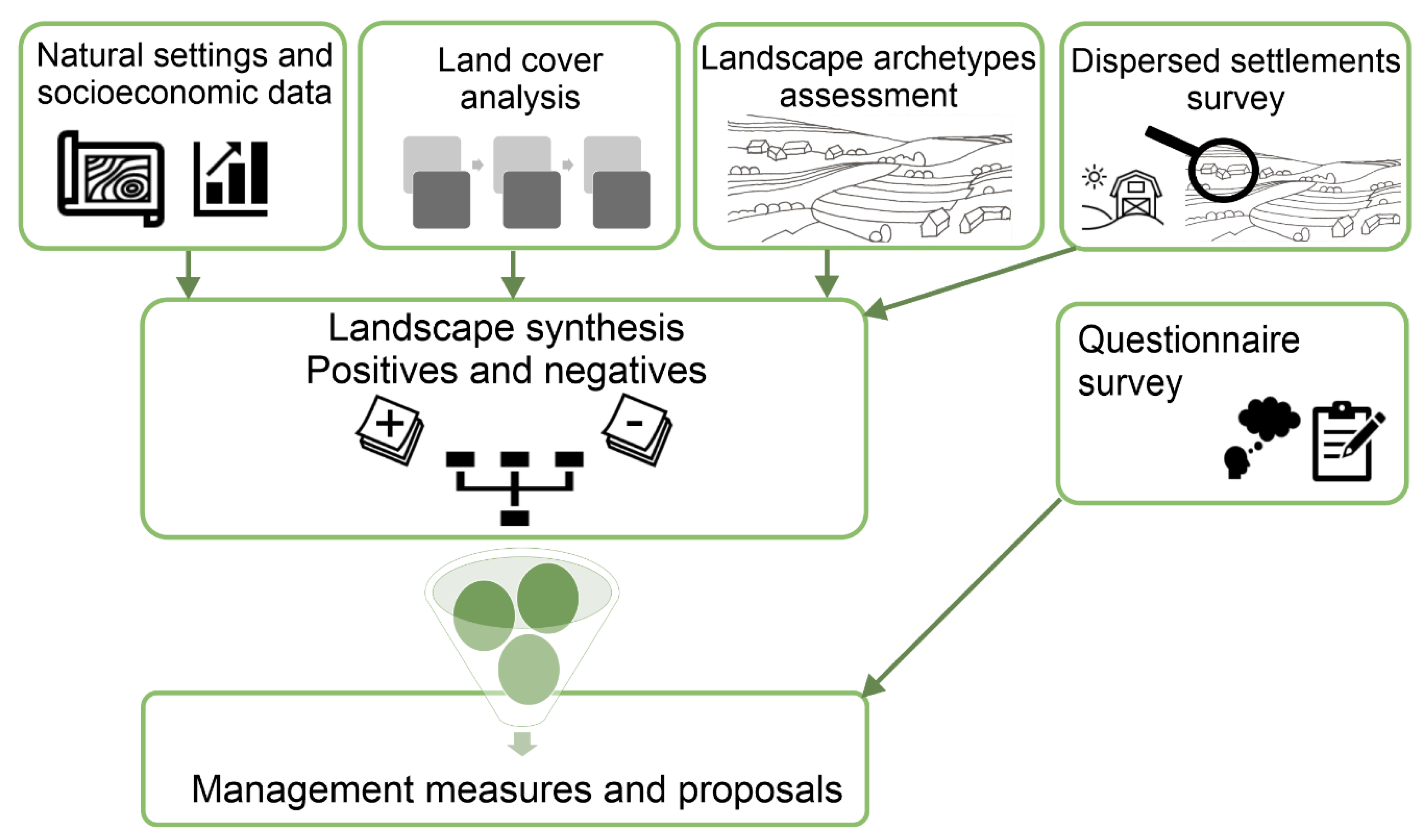

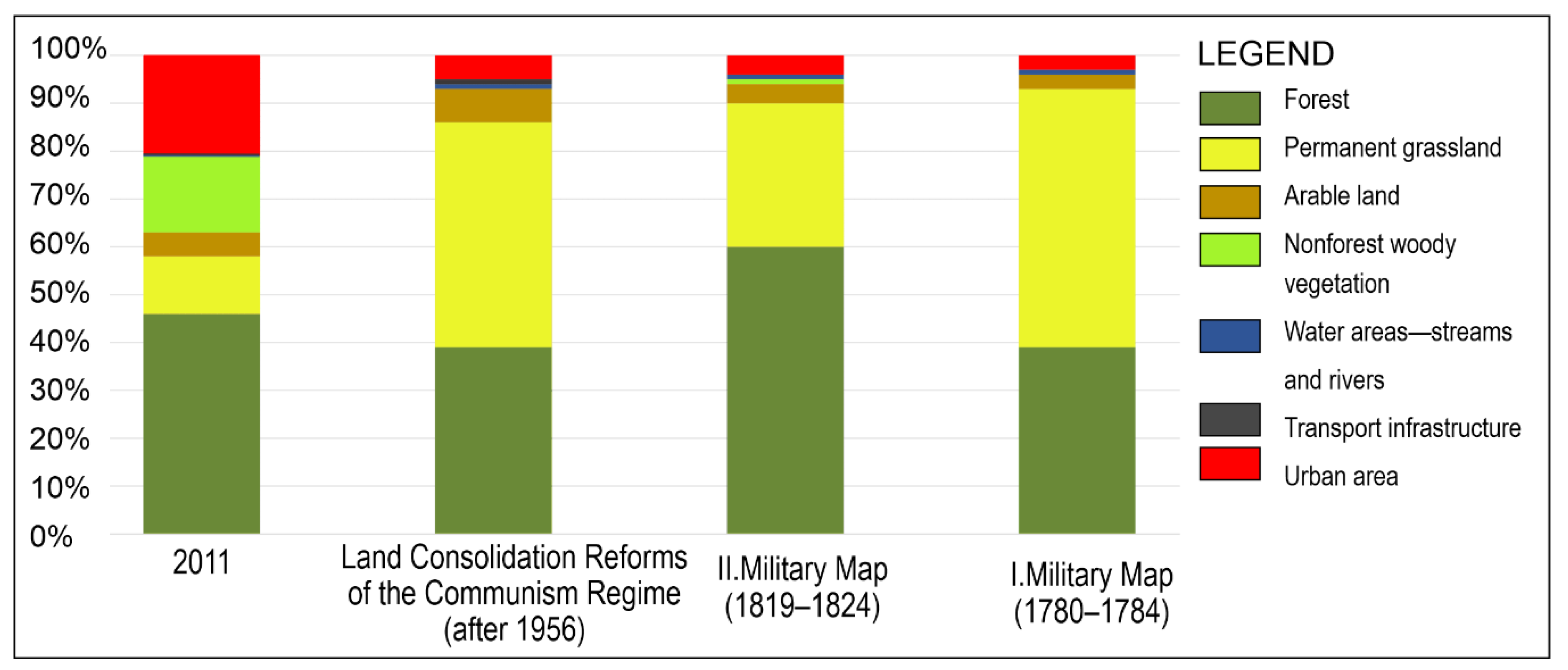
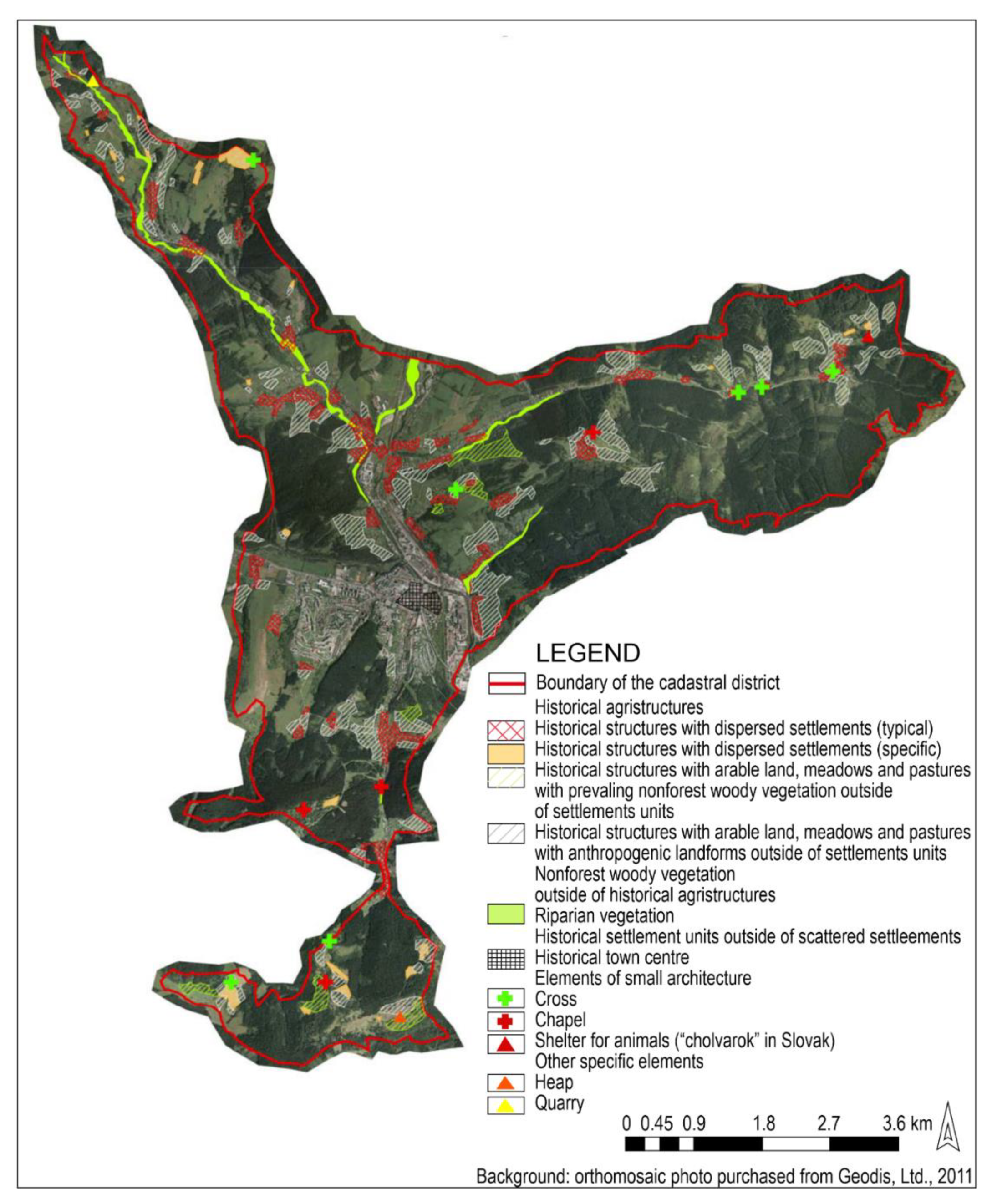
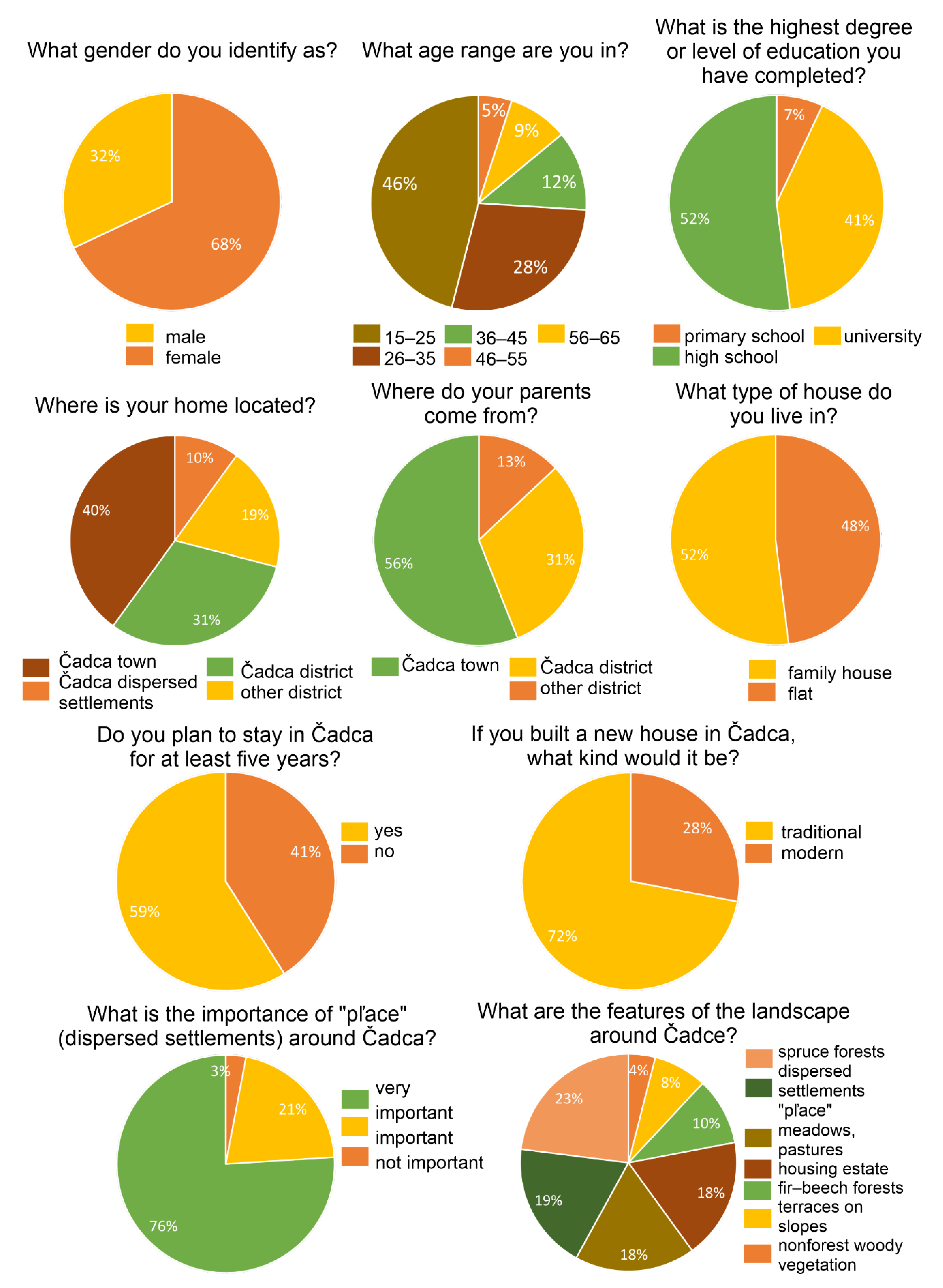
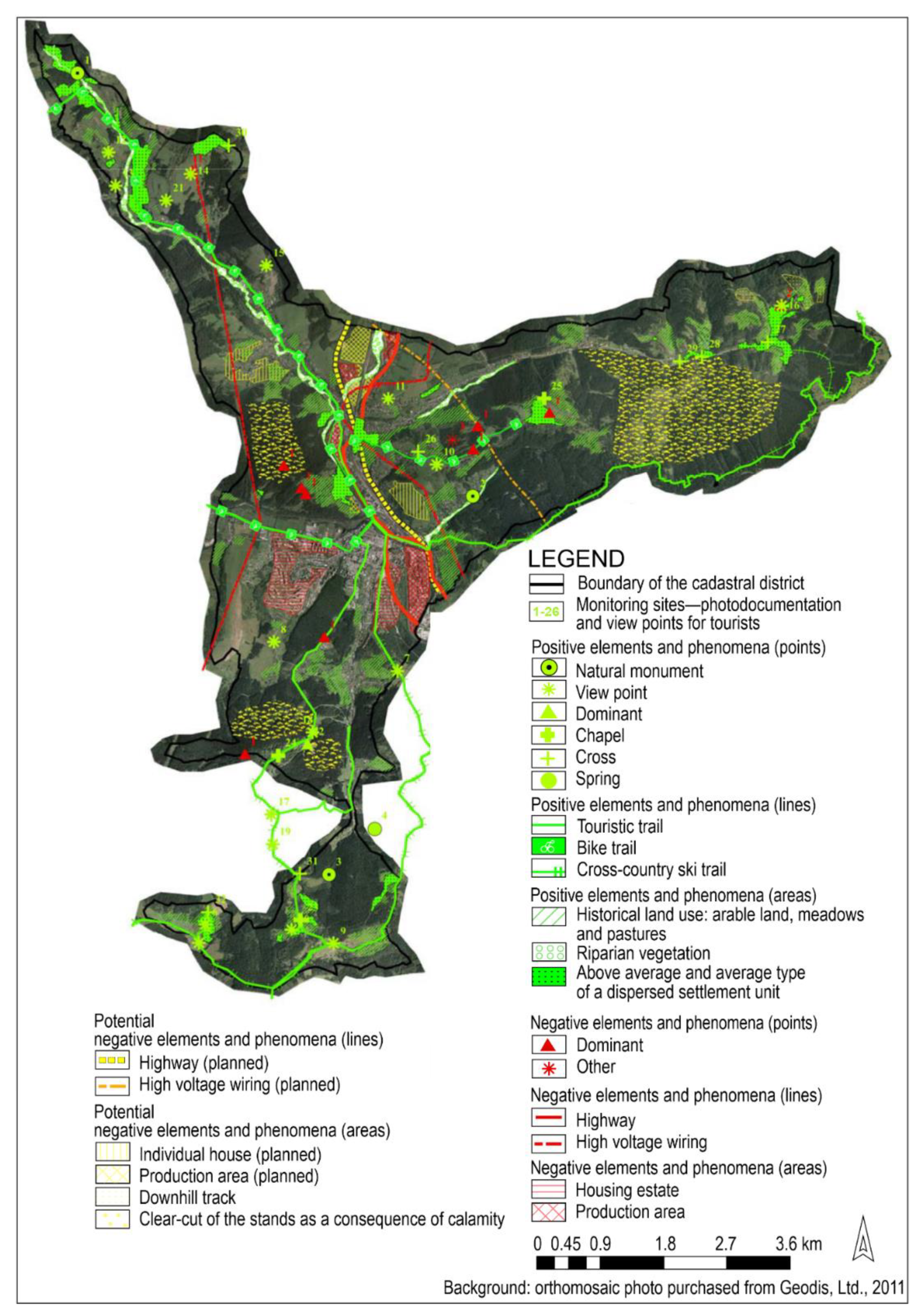
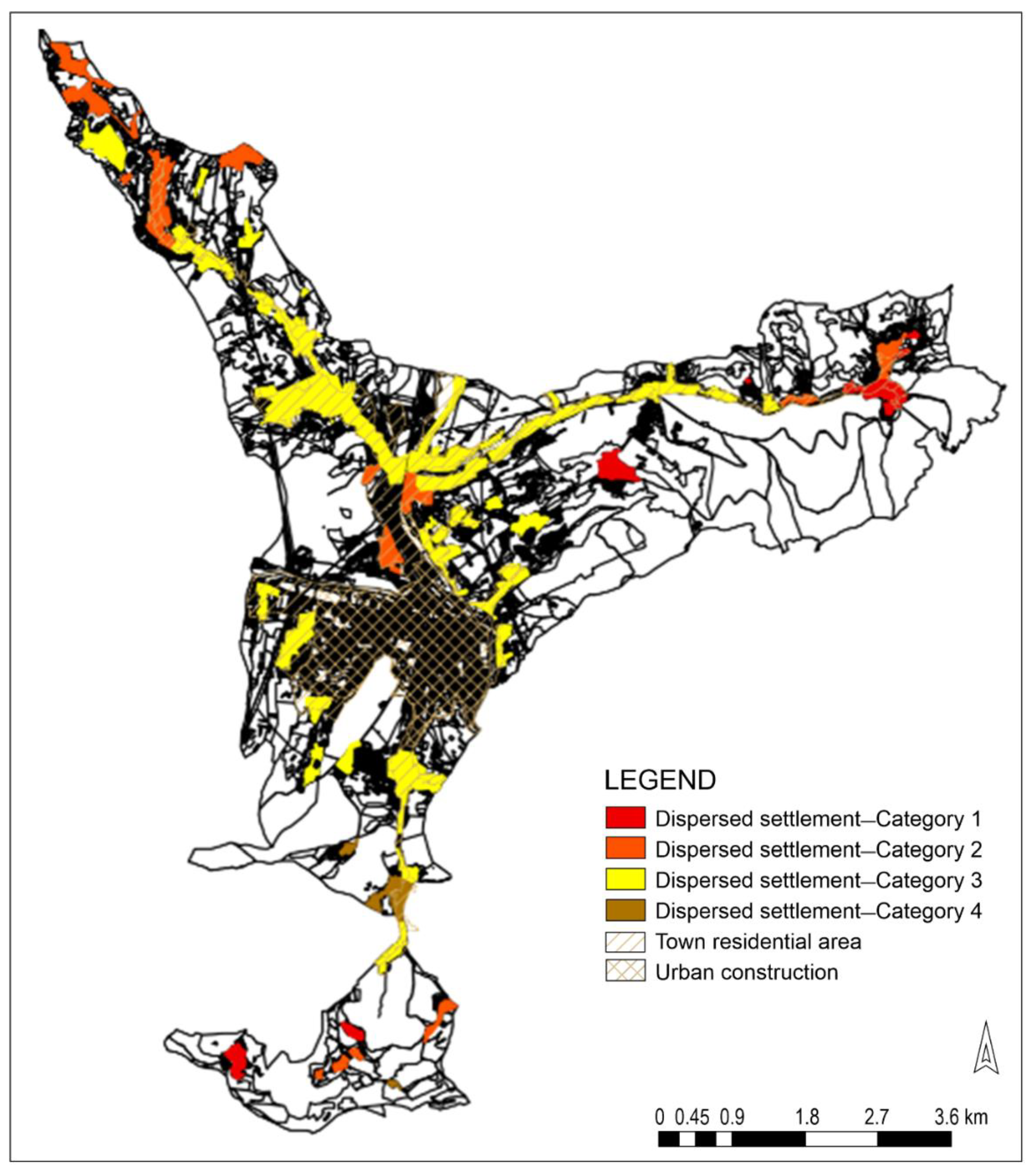

| Population | Population of Village Centers | Population of Dispersed Parts | Share of Population in Settlement Centers (%) | Population of Dispersed Settlements (%) | |
|---|---|---|---|---|---|
| 1961 | 11,620 | 8556 | 3064 | 73.6 | 26.4 |
| 2007 | 25,751 | 19,533 | 6218 | 75.79 | 24.14 |
| 2012 | 25,144 | 18,659 | 6485 | 74.21 | 25.79 |
| Difference (in %) 2007–2012 | −2.35 | −4.47 | 4.29 | −1.58 | 1.65 |
| Difference (in %) 1961–2012 | 216.38 | 218.08 | 211.65 | 1.39 | −0.61 |
Publisher’s Note: MDPI stays neutral with regard to jurisdictional claims in published maps and institutional affiliations. |
© 2021 by the authors. Licensee MDPI, Basel, Switzerland. This article is an open access article distributed under the terms and conditions of the Creative Commons Attribution (CC BY) license (http://creativecommons.org/licenses/by/4.0/).
Share and Cite
Belčáková, I.; Olah, B.; Slámová, M.; Pšenáková, Z. A Cultural and Environmental Assessment of a Landscape Archetype with Dispersed Settlements in Čadca Cadastral District, Slovakia. Sustainability 2021, 13, 1200. https://doi.org/10.3390/su13031200
Belčáková I, Olah B, Slámová M, Pšenáková Z. A Cultural and Environmental Assessment of a Landscape Archetype with Dispersed Settlements in Čadca Cadastral District, Slovakia. Sustainability. 2021; 13(3):1200. https://doi.org/10.3390/su13031200
Chicago/Turabian StyleBelčáková, Ingrid, Branislav Olah, Martina Slámová, and Zuzana Pšenáková. 2021. "A Cultural and Environmental Assessment of a Landscape Archetype with Dispersed Settlements in Čadca Cadastral District, Slovakia" Sustainability 13, no. 3: 1200. https://doi.org/10.3390/su13031200
APA StyleBelčáková, I., Olah, B., Slámová, M., & Pšenáková, Z. (2021). A Cultural and Environmental Assessment of a Landscape Archetype with Dispersed Settlements in Čadca Cadastral District, Slovakia. Sustainability, 13(3), 1200. https://doi.org/10.3390/su13031200









